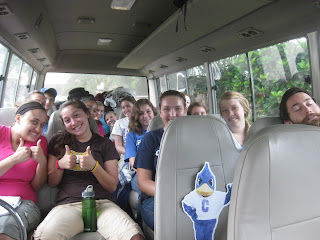9 de Septiembre de dos mil once Viernes
"Our guide repeated many times that we needed to spread the word to other students so they can play a part in paying a living wage by their purchases of Alta Gracia spiritwear shirts."
Today nuestra communidad doce woke up early to leave after our breakfast here in ILAC on the gringo guagua, driven by Edwin. We traveled southeast on the highway out of Santiago toward Santo Domingo. After a couple of hours driving past the mountains of the cordillera central, through the campo, over streams, and past huge orange groves, we stopped about forty kilometers outside of Santo Domingo in the town of Alta Gracia, meaning "exalted grace" after Nuestra Senora de Alta Gracia, the patroness of the Dominican Republic.
Alta Gracia is the kind of town which you could drive through in five to ten minutes, winding your way through the moto-filled streets. We pulled up to a large metal building the size of those huge metal barns you might pass traveling through rural Nebraska. We all piled out and, after filing inside Fabrica Alta Gracia we stood for a moment taking in the loud Merengue playing over the sound of the four busy sewing lines and bustle of Dominicans methodically sewing and folding shirts. After meeting with a few of the Union leaders, we were lead about the factory on a tour, viewing the steps of production. We watched a worker cut the rough shirt forms from the wide bolts of cloth, unrolled into a sandwich of layers with something that looked like a jigsaw.
The union leader related the story of their efforts of seven years to accomplish unionization under the abusive management of the previous owners of the building, BJ&B, a Korean cap company. Despite threats of being fired and a growing struggle in concert with United Students Against Sweatshops (USAS) and other workers' rights groups they finally accomplished unionization. However, BJ&B moved many jobs to their other factories in other third world countries and eventually closed the factory. The workers were forced to find jobs in Santiago, the capital, or other free trade zones at the same minimum wage which never allowed those with families to get ahead, but simply survive. Since then, the factory was bought and reopened by Knights Apparel, a corporation which sells spirit wear in University bookstores throughout the US. The owner, Joseph Bozich, decided that he could afford to pay the workers three and a half times the minimum wage, which is the calculated living wage for a family of four in the Dominican Republic (calculated by the Workers Rights Consortium, a branch of USAS), and absorb the extra production costs without marking up the wholesale price to retailers. However, the line is now being supported by the other Knights Apparel lines, and until they can begin expanding the Alta Gracia line to include other clothes besides tee shirts, students need to purchase Alta Gracia shirts at their bookstores to keep the Alta Gracia factory in business. A few Comunidad Doce members recorded a video interview with one of the workers, who stated that in his own words as well.Our guide repeated many times that we needed to spread the word to other students so they can play a part in paying a living wage by their purchases of Alta Gracia spiritwear shirts.
We continued through the factory observing all the steps in production, from cutting, sewing, inspecting, folding, tagging, and packing them in boxes. She continued to relate the improvement in their working conditions with Knights Apparel, the promptly paid and respectfully requested overtime, the paid maternity leave, the bathroom breaks and clean drinking water, which made their work dignified and filled them with hope. We watched as the bell rang for the end of the day and all the workers quickly lined up to clock out, jostling and laughing like school children, excited for the weekend.










